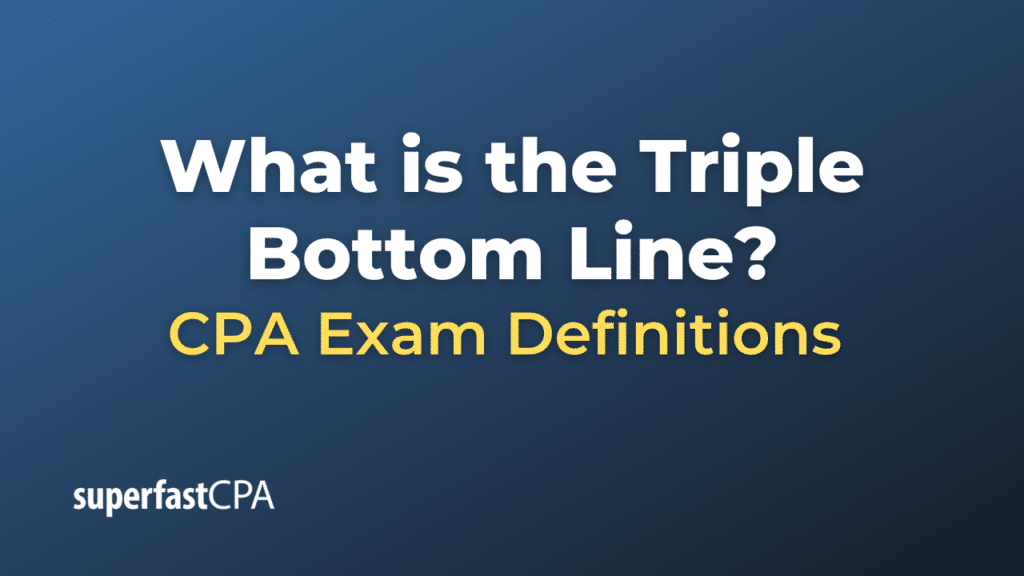Triple Bottom Line
The Triple Bottom Line (TBL) is a concept that encourages companies to focus not only on financial profitability but also on social and environmental impacts. The idea is to evaluate organizational performance in a broader perspective to create greater business value. The term was popularized by John Elkington in the mid-1990s.
The Triple Bottom Line is often referred to as the “three Ps”:
- Profit (Economic Value) : This is the traditional measure of corporate profit—the bottom line of the P&L (Profit & Loss) Account.
- People (Social Value): This measures how socially responsible an organization has been throughout its operations. This can include everything from employee wages, work conditions, and community involvement to impact on health and the benefit the public receives from a company’s products or services.
- Planet (Environmental Value): This measures the environmental impacts and the organization’s ecological responsibility. This can encompass energy use, waste generation, natural resource consumption, and the company’s treatment of the environment.
Benefits of adopting the Triple Bottom Line approach:
- Holistic View of Performance: TBL offers a comprehensive view of a company’s performance and the impacts of its operations on various stakeholders.
- Risk Management: Addressing social and environmental issues can help companies mitigate risks, particularly those related to regulations, reputation, and potential liabilities.
- Brand Image & Reputation: Companies that adhere to TBL principles can enhance their reputation, leading to increased loyalty among customers and stakeholders.
- Long-term Profitability: By considering long-term sustainability and stakeholder interests, companies may realize improved long-term profitability and business resilience.
However, the challenge with TBL is that measuring performance in social and environmental terms isn’t always straightforward. There isn’t a single universally accepted standard or methodology to quantify all aspects of social and environmental performance. Despite this, many companies and organizations have adopted the TBL framework or similar concepts as they recognize the importance of sustainable and responsible business practices in today’s world.
Example of the Triple Bottom Line
Let’s consider the example of a fictional coffee company, “BeanGreen Coffee Co.,” that implements the Triple Bottom Line (TBL) approach:
- Profit (Economic Value):
- Traditional Metrics: BeanGreen Coffee Co. reports an annual profit of $5 million from selling coffee and related products.
- TBL Approach: The company also invests a portion of its profits in sustainable farming initiatives and in education programs in coffee-growing regions.
- People (Social Value):
- Traditional Metrics: The company employs 500 people and provides products to millions of customers.
- TBL Approach: BeanGreen ensures:
- Fair wages for both its employees in stores and for farmers in its supply chain.
- A healthy and safe working environment in both its coffee shops and at the farms from which they source beans.
- Engagement with local communities where they operate, such as sponsoring community events or contributing to local charities.
- Employee training programs and opportunities for advancement, fostering a positive and inclusive corporate culture.
- Planet (Environmental Value):
- Traditional Metrics: BeanGreen uses water, energy, and produces waste in its coffee production and shop operations.
- TBL Approach: The company implements:
- Sourcing beans from farms that use sustainable and organic farming methods.
- Implementing water-saving measures in their coffee shops.
- Using renewable energy sources where possible.
- Offering a discount to customers who bring their own reusable cups, thereby reducing waste.
- Implementing a robust recycling and composting program.
- Regularly publishing a sustainability report, outlining their environmental impact and future goals.
By adopting the TBL approach, BeanGreen Coffee Co. isn’t just focused on its financial bottom line. It’s actively ensuring it leaves a positive mark on society and the environment. As a result, the company gains a competitive advantage: a positive brand image, loyal customers who align with their values, and potentially, over the long term, cost savings from some of its sustainable initiatives.














